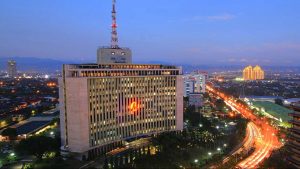Small Philippine firms fail to scale in absence of capital

By Beatriz Marie D. Cruz, Reporter
EVA P. GOZON, 36, withdrew her life insurance fund and combined it with her bonus from her job as an outsourcing agent to fund her fried siopao business in Pasay City near the Philippine capital.
She considered applying for a small business loan worth P200,000 at a local bank, but decided against it due to high interest rates. “I got scared,” she told BusinessWorld by telephone.
“After much study, I found out that I would have had to use all my profits to pay for the loan,” she said. “There were also too many paper requirements. It really wasn’t worth it.”
Philippine banks have failed to lend 10% of their loan portfolio to micro-, small- and medium-sized enterprises (MSME), as required by law, and would rather pay the fine than risk not being paid.
Data from the Philippine central bank showed that as of end-June, banks only lent 4.52% or P488.13 billion of their P10.8-trillion loan portfolio to MSMEs, which are known for their crucial role in fostering broad-based development, acting as the backbone of the economy.
These firms account for more than 99% of all businesses in the Philippines and provide jobs to many Filipinos, making them a key player in shaping the economic landscape.
Under the law, 8% of banking loans must go to micro and small enterprises, and 2% to medium-sized firms. But as of end-June, banks only lent 1.82% of their loans to micro and small enterprises and 2.7% to medium-sized businesses.
Banks barely know the owners and the nature of their businesses and consider them risky clients, Diwa C. Guinigundo, Philippine analyst at GlobalSource Partners and a former deputy governor at the Bangko Sentral ng Pilipinas (BSP), said in a Viber message.
“They have little knowledge about small businesses’ track record and when information is limited, banks would rather pay their fines than expose themselves to what they consider to be risky clients,” he said.
MSMEs have a limited financial history and a “higher vulnerability to economic downturns,” said Ben Joshua A. Baltazar, president and chief executive officer at the state-owned Credit Information Corp.
“This was further exacerbated by banks’ experience during and after the pandemic when some MSMEs were not able to repay loans on time due to lockdowns and physical distancing, which affected the businesses’ profitability,” he said in an e-mail.
There is also an information gap on smaller firms’ credit records, Mr. Baltazar said, adding that MSMEs’ financial history and collaterals should be properly documented so banks could use these as the basis for their loans.
“Banks want to minimize nonperforming loans while increasing loans to the creditworthy,” he said. “However, they are unable to collect this information reliably and MSMEs have no established method to prove good credit behavior.”
Meanwhile, small entrepreneurs are reluctant to avail themselves of a loan due to high interest rates especially if they lack collateral, Mr. Baltazar said.
“Being a segment where businesses are thriving or transitioning, many MSMEs are afraid of applying for a loan, anticipating similar requirements and processes as that of the commercial loan facilities,” BDO Network Bank, the country’s biggest rural bank, said in an e-mailed reply to questions.
When applying for a bank loan, MSMEs are usually asked to prepare personal financial and bank statements, references from business networks and a risk assessment, BDO Unibank, Inc.’s rural banking arm pointed out.
‘ASYMMETRY OF INFORMATION’In the first half, universal and commercial banks lent P134.1 billion to micro and small enterprises, or 1.35% of their total loans, and P235.8 billion or 2.38% of their total lending to medium enterprises. Thrift banks allotted 3.74% of their loans to micro and small enterprises, and 5.39% to medium-sized businesses.
Digital banks lent P250 million or 1.41% of their total credits to micro and small businesses, and P30 million or 0.16% to medium enterprises, BSP data showed.
On the other hand, rural and cooperative lenders have been more generous in lending to MSMEs, probably because they are more familiar with their conditions on the ground.
During the period, these institutions released loans worth P37.9 billion to micro and small enterprises, equivalent to 17.61% of their total credit books. Their loans to medium enterprises hit P19.9 billion or 9.26% of the total. These are both well beyond the minimums required by law.
“There is asymmetry of information between the big banks and smaller institutions like rural banks, which are mostly compliant,” Mr. Guinigundo said. “They are on the ground, and they know their clients.”
“A good credit information bureau that caters to all banks would provide a level playing field for both banks and their small business clients,” he added.
Banks need “data-driven and risk-based” lending to expand their MSME base, Mr. Baltazar said. “The demand-side barriers that continue to hamper MSMEs’ access to finance are lenders’ conservative high interest rates and collateral requirements, which deter borrowers.”
Mr. Guinigundo noted that if banks were more transparent about their lending policies, and small business clients too about their creditworthiness, “perhaps a better pricing discovery can be established, leading to more loans to small business and more decent interest rates on the loans.”
Banks also have the duty to diversify their financial products through flexible payment options and timelines to attract more MSME borrowers.
BDO Network Bank said big banks that deal with MSMEs are usually focused on lending under the “term loan” format — a fixed amount is borrowed for a specified period, typically ranging from one to 10 years, to be paid in regular installments over time.
“Diversifying into other credit options such as providing lines of credit that are revolving or loans that mature quickly for easy rollover will further support MSME growth,” it added.
Banks should also have flexible collateral requirements and financial literacy programs to make their loan products less intimidating to small firms. “Banks should have the ability to provide secured loans with collateral requirements that are more flexible compared with the conventional secured loan standards.”
But Anna Angeli B. Alberto, 41, could not be bothered by banks’ paper requirements. Instead of going to the bank, she used her credit card to set up a stall for her frozen meat and cooked rice meal business inside a food court at SOMO Market in Bacoor, Cavite province.
“It’s hassle-free,” she said by phone. “There are no requirements needed, and the loan release is instant.”




